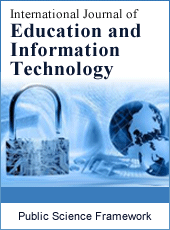International Journal of Education and Information Technology
Articles Information
International Journal of Education and Information Technology, Vol.1, No.2, Jun. 2015, Pub. Date: Apr. 22, 2015
A Study on the Effectiveness of Flipped Teaching in College Math Classroom
Pages: 29-33 Views: 5757 Downloads: 3266
[01]
Mohammad Shafique, School of Continuing Education, Centennial College, Toronto ON, Canada.
[02]
Heather Irwin-Robinson, School of Continuing Education, Centennial College, Toronto ON, Canada.
The purpose of this work is to study how to teach mathematical skills and to determine what effectiveness of flipped teaching in College math classroom for student’s achievement in the course. Many researchers are involved in their research work reporting about flip classroom by using different pedagogical approaches. In this work, the effectiveness of flipped Math classroom has been studied by carrying out two types of student surveys and analyzed by using basic statistical tools. The data has been collected on a small scale to analyze the opinion of the students and examined statistically. The results are in good agreement and given in tabular as well as in graphical form. The conclusion and suggestion for work have been given as well.
Flipped Teaching, College Math Classroom, Surveys, Basic Statistical Tools
[01]
Alvarez, B. (2011). Flipping the classroom: Homework in class, lessons at home. Learning First. http://www.learningfirst. org/flipping-classroom-homework-class-lessons-home.
[02]
Berrett, D. (2011). How ‘Flipping’ the classroom can improve the traditional lecture. From http://chronicle.com/article/How-Flipping-the-Classroom/130857/.
[03]
Baker, J. W., & Mentch, M. W. (2000). IMOWA curriculum materials. From http://www.imowa.org/curricula/flip/.
[04]
Bergmann, J., & Sams, A. (2012). Before you flip, Phi Delta Kappan, 94(2), 25.
[05]
Davies, R. (2011). Understanding technology literacy: A framework for evaluating educational technology integration. TechTrends, 55(5), 45–52.
[06]
Demetry, C. (2010). Work in Progress – An Innovation Merging “Classroom Flip” and Team-Based Learning. 40th ASEE/IEEE Frontiers in Education Conference, T1E-1-2.
[07]
Dove, A. & Dove, E. (2014). Examining the influence of a flipped classroom approach in mathematics. Proceedings of Society for Information Technology & Teacher Education International Conference 2014 (pp. 1230-1236).
[08]
Dziuban, C. D. (2004). Blended learning. In C. O. Boulder (Ed.), Educause center for applied research. from http://net.educause.edu/ir/library/pdf/ERB0407.pdf.
[09]
Fulton, K. P. (2012). 10 reasons to flip. Phi Delta Kappan, 94(2), 20–24.
[10]
Houston, M. and Lin, L. (2012). Humanizing the Classroom by Flipping the Homework versus Lecture Equation. Proceedings for Society for Information Technology &Teacher Education International Conference 2012. PP.1177-1182.
[11]
Hughes, H. (2012). Introduction to flipping the college classroom. In T. Amiel & B. Wilson (Eds.), Proceedings from world conference on educational multimedia, hypermedia and telecommunications. PP. 2434–2438. Chesapeake: AACE.
[12]
Kirschner, P., Strijbos, J.W., Kreijns, K., & Beers, P.J. (2004). Designing electronic collaborative learning environments. Educational Tech: Research and Development, 52(3), 47–66.
[13]
Kleiman, G. M. (2000). Myths and realities about technology in K-12 schools. In the harvard education letter report. The digital classroom: How technology is changing the way we teach and learn. from http://www.edletter.org/dc/kleiman.htm.
[14]
Lage, M.J., Platt, G. J., Treglia, M. (2000). Inverting the Classroom: A Gateway to Creating an Inclusive Learning Environment. J. of Economic Education, v.31, Part I, 30-41.
[15]
Moravec, M., Williams, A., Aguilar-Roca, N., & O’Dowd, D. K. (2010). Learn before lecture: a strategy that improves learning outcomes in a large introductory biology class. CBE Life Sciences Education, 9, 473–481.
[16]
Novak, G. M. (2011). Just-in-time teaching. New Directions for Teaching and Learning, 2011(128), 63–73.
[17]
Strayer, J. F. (2012). How learning in an inverted classroom influences cooperation, innovation and task orientation. Learning Environments Research, 15(2), 171–193.
[18]
Strayer J F, (2007), The Effects of the Classroom Flip on the Learning Environment: A Comparison of Learning Activity in a Traditional Classroom and a Flip Classroom that used an Intelligent Tutoring System, Ph D Thesis, the Ohio State Uni.
[19]
Talbert, R. (2012). Inverted classroom. Colleagues, 9(1), A7.
[20]
Zappe, S., Leicht, R., Messner, J., Litzinger, T., and Lee, H.W. (2009). “Flipping” the Classroom to Explore Active Learning in a Large Undergraduate Course. American Society for Engineering Education 2009 Annual Conference.
[21]
Gila Kurtz , Alexandr Tsimerman, Orna Steiner-Lavi. (2014). The flipped-classroom approach: The answer to future learning?. European Journal of Open, Distance and e-Learning, Vol. 17 (2), 171-181.
[22]
Jean McGivney-Burelle & Fei Xue (2013) Flipping Calculus, Problems, Resources, and Issues in Mathematics Undergraduate Studies, 23:5, 477-486.

ISSN Print: 2381-7410
ISSN Online: 2381-7429
Current Issue:
Vol. 5, Issue 1, March Submit a Manuscript Join Editorial Board Join Reviewer Team
ISSN Online: 2381-7429
Current Issue:
Vol. 5, Issue 1, March Submit a Manuscript Join Editorial Board Join Reviewer Team
| About This Journal |
| All Issues |
| Open Access |
| Indexing |
| Payment Information |
| Author Guidelines |
| Review Process |
| Publication Ethics |
| Editorial Board |
| Peer Reviewers |


